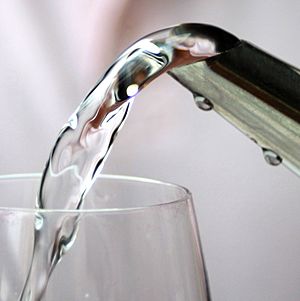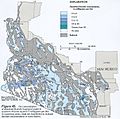Fluoridation facts for kids
Fluoridation is when tiny amounts of fluorine compounds, called fluorides, are added to different things. You often find fluoride in toothpaste and drinking water. Many experts, like government officials, scientists, and doctors, agree that adding fluoride helps stop tooth decay and cavities.
Water fluoridation means carefully adding fluoride to a public water supply. This is done to help reduce tooth decay. Water that has fluoride added contains just enough to help prevent cavities. Sometimes, water naturally has fluoride in it, or it can be added by people.

Fluoridated water works directly on the surface of your teeth. When you drink it, a small amount of fluoride gets into your saliva. This fluoride helps slow down how fast your tooth enamel wears away. It also helps your teeth rebuild their enamel in the early stages of a cavity.
Adding fluoride to drinking water is a common practice. In the U.S., it costs about $1.20 per person each year. If water naturally has too much fluoride, it needs to be removed. In 2011, the World Health Organization suggested a fluoride level of 0.5 to 1.5 milligrams per liter. This amount can change based on the climate and other fluoride sources nearby. Bottled water often has unknown levels of fluoride.
Contents
Why is Fluoridation Important?
Cavities are still a big health issue in most developed countries. They affect many schoolchildren (60-90%) and most adults. Adding fluoride to water helps reduce cavities in children. Its effect on adults is not as clear.
Does Fluoridation Have Side Effects?
Sometimes, fluoridation can cause something called dental fluorosis. This can change how developing teeth look, like causing very mild white streaks. However, these changes are usually not noticeable or a big health concern. There is no strong evidence that water fluoridation causes other harmful effects.
How Fluoride Protects Teeth
Fluoride's benefits depend on the total amount of fluoride a person gets each day from all sources. Drinking water is usually the main source. But fluoride can also be found in toothpaste, salt, and milk. Experts have different ideas about the best way to prevent tooth decay in a community. The Australian government believes that water fluoridation is the most effective way to give fluoride to everyone.
Where is Water Fluoridation Used?
Public water fluoridation first started in the U.S. By 2012, 25 countries around the world had artificial water fluoridation. In 11 of these countries, more than half their population drank fluoridated water. Another 28 countries had water that was naturally fluoridated. However, in many of these places, the natural fluoride level was higher than recommended. In 2012, about 435 million people globally received water with the recommended level of fluoride. This is about 5.4% of the world's population.
Debates About Fluoridation
Even though it's widely used, water fluoridation is still a debated topic in public health. Some countries and communities have stopped it, while others have expanded it. People who are against it argue that the benefits and risks haven't been studied enough. They also debate if it's right to give medication to everyone through water, which some see as a limit on individual freedom.
Other pages
Images for kids
-
A mild case of dental fluorosis, seen as white streaks on the upper right front tooth.
-
This is fluoridated iodized salt sold in Germany.
-
H. Trendley Dean began studying fluoride's harm in 1931. By 1950, he showed that small amounts could prevent cavities.
See also
 In Spanish: Fluoración del agua potable para niños
In Spanish: Fluoración del agua potable para niños









